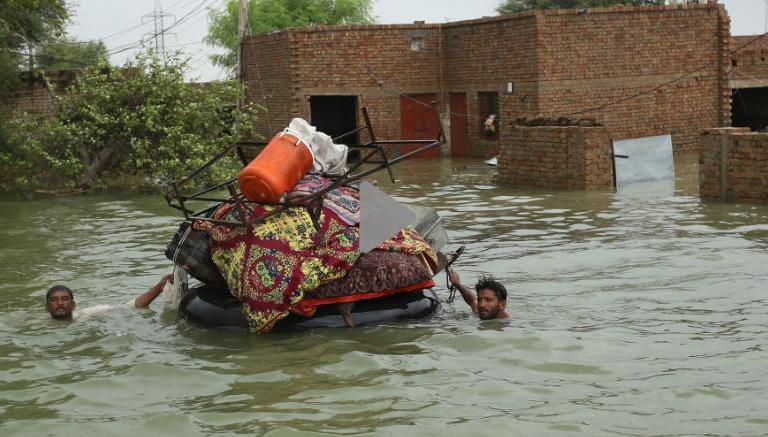Historic Flooding In Pakistan
Leaves One Third Of The Nation Under Water In
Climate Change Disaster Confirming Previous Site
Claims
September 5. 2022

Pakistan floods cover 1/3 of the country
For the past year I have been
warning on this site (and for even longer on
my Twitter page) that the climate change problem in
the world has
accelerated, especially as it pertains to natural
disasters via water.
My warnings have since proven correct, as a
number of HISTORIC, RECORD AND UNPRECEDENTED events have occurred
since that time illustrating the
truth in my statements: 'Doomsday Glacier' In Antarctica
Under Imminent Risk Of Collapse Confirming Previous Claims and
Yellowstone Floods In Unprecedented
Climate Event Confirming Previous Site Claims (Videos)
and
Kentucky Experiences Deadly And
Unprecedented Flooding Confirming Previous Statements About Climate
Change (Videos) and
Florida Is Experiencing Record
Flooding Confirming Previous Site Claims and
NASA Warns About Wobbling Moon
Causing Global Flooding Confirming Previous Claims.
Over the past few days Pakistan has
experienced HISTORIC, RECORD AND UNPRECEDENTED
flooding that has left one third of the nation
underwater. The images coming out of Pakistan is
heartbreaking. This type of widespread devastation
is not something any nation is truly equipped to
deal with and they will need global assistance.
CNN reported, "'Outbursts' from Pakistan's melting glaciers have
tripled this year and are worsening floods. 'As we
continue to see more and more extreme weather events
around the world, it is outrageous that climate
action is being put on the back burner as global
emissions of greenhouse gases are still rising,
putting all of us -- everywhere -- in growing
danger'...".
In the June 15, 2022 article "Yellowstone Floods In Unprecedented
Climate Event Confirming Previous Site Claims (Videos)" I stated
regarding the Doomsday Glacier in Antarctica known
as Thwaites, "Other glaciers are melting at an
accelerated rate as
well, and if allowed to reach full hilt without a proper scientific
intervention, it will create unprecedented sea rise that will wipeout costal areas."
My statements have again proven
true, as 3-MONTHS after my aforementioned article
CNN reported on September 2, 2022 that glacial melt
greatly contributed to the current floods in
Pakistan, which have wreaked havoc, "Pakistan is
also home to more glaciers than anywhere outside the
polar regions. But as the climate warms, it's
becoming more vulnerable to sudden outbursts of
melting glacier water" (see STORY SOURCE below for
cited CNN article excerpt).
STORY SOURCE
A third of Pakistan is underwater amid its
worst floods in history. Here's what you need to
know
Updated 6:08 AM ET, Fri September 2,
2022 - A European Space Agency satellite image on
August 30, 2022 shows the extent of flooding that
has devastated Pakistan. (CNN) More than one third
of Pakistan is underwater, according to satellite
images from the European Space Agency (ESA), as
deadly floodwaters threaten to create secondary
disasters.
Food is in short supply after water
covered millions of acres of crops and wiped out
hundreds of thousands of livestock. Meanwhile, aid
agencies have warned of an uptick in infectious
diseases, leaving millions vulnerable to illness
caused by what the United Nations has called a
"monsoon on steroids."
More than 1,100 people have died
from the floods since mid-June, nearly 400 of them
children, while millions have been displaced,
according to Pakistan's National Disaster Management
Authority (NDMA).
Pakistan, which was already
grappling with political and economic turmoil, has
been thrown into the front line of the human-induced
climate crisis. Pakistan's monsoon season usually
brings heavy downpours, but this year's has been the
wettest since records began in 1961, according to
the Pakistan Meteorological Department.
Torrential monsoon rainfall -- 10 times heavier than
usual -- has caused the Indus River to overflow,
effectively creating a long lake, tens of kilometers
wide, according to images from the ESA on August 30...
'Outbursts' from Pakistan's melting glaciers have
tripled this year and are worsening floods.
"As we continue to see more and more extreme weather
events around the world, it is outrageous that
climate action is being put on the back burner as
global emissions of greenhouse gases are still
rising, putting all of us -- everywhere -- in
growing danger," he added.
Pakistan is also home to more glaciers than anywhere
outside the polar regions. But as the climate warms,
it's becoming more vulnerable to sudden outbursts of
melting glacier water...
https://www.cnn.com
Why are Pakistanís floods so extreme
this year?
02 September 2022 -
One-third of the country is under water, following
an intense heatwave and a long monsoon that has
dumped a record amount of rain. People gather in front of a road
damaged by flood water, surrounded by yellow tape.
With rivers breaking their banks,
flash flooding and glacial lakes bursting, Pakistan
is experiencing its worst floods this century. At
least one-third of the country is under water.
Scientists say several factors have contributed to
the extreme event, which has displaced some 33
million people and killed more than 1,200...
Glacial melt
The intense heat also melted
glaciers in the northern mountainous regions,
increasing the amount of water flowing into
tributaries that eventually make their way into the
Indus river, says Athar Hussain, a climate scientist
at COMSATS University Islamabad. The Indus is
Pakistanís largest river, and runs the length of the
country from north to south, feeding towns, cities
and large swathes of agricultural land along the
way. It isnít clear exactly how much excess glacial
melt has flowed into rivers this year, but Hashmi
visited some high-altitude glaciated regions in July
and noticed high flows and muddy water in the Hunza
River, which feeds into the Indus. He says the mud
suggests that there has been rapid melting, because
fast water picks up sediment as it moves downstream.
Several glacial lakes have burst through the dams of
ice that normally restrain them, releasing a
dangerous rush of water...
https://www.nature.com
RELATED ARTICLES
Site Exclusives

